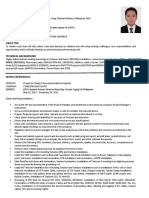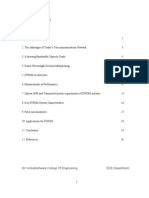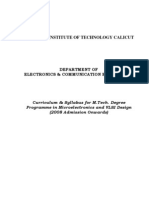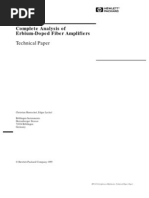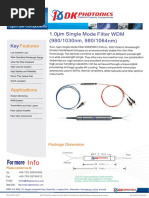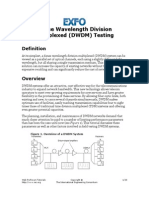Fiber Optic Network Design From Madang To Lae - Second Part
Fiber Optic Network Design From Madang To Lae - Second Part
Uploaded by
Jeremiah NapiCopyright:
Available Formats
Fiber Optic Network Design From Madang To Lae - Second Part
Fiber Optic Network Design From Madang To Lae - Second Part
Uploaded by
Jeremiah NapiOriginal Title
Copyright
Available Formats
Share this document
Did you find this document useful?
Is this content inappropriate?
Copyright:
Available Formats
Fiber Optic Network Design From Madang To Lae - Second Part
Fiber Optic Network Design From Madang To Lae - Second Part
Uploaded by
Jeremiah NapiCopyright:
Available Formats
FIBER OPTIC LINK BUDGET DESIGN
Optic Cables using WDM network system to connect Lae and Madang-Papua New Guinea
A PROJECT REPORT
Submitted by
Mr. Jeremiah. Napi (08600131)
Under the Supervision of
Mr. Manu Rawali
In partial fulfillment of the award of the degree of
BACHELOR OF SCIENCE IN APPLIED PHYSICS WITH ELECTRONICS AND INSTRUMENTATION
At
THE PAPUA NEW GUINEA UNIVERSITY OF TECHNOLOGY September 2011
Fiber Optic Link Design Report
FIBER OPTIC LINK BUDGET DESIGN
Optic Cables using WDM network system to connect Lae and Madang-Papua New Guinea
A PROJECT REPORT
Submitted by
Mr. Jeremiah. Napi (08600131)
Under the Supervision of
Mr. Manu Rawali
In partial fulfillment of the award of the degree of
BACHELOR OF SCIENCE IN APPLIED PHYSICS WITH ELECTRONICS AND INSTRUMENTATION
At
THE PAPUA NEW GUINEA UNIVERSITY OF TECHNOLOGY September 2011
APPLIED PHYSICS WITH ELECTRONICS AND INSTRUMENTATIONS
Fiber Optic Link Design Report
Preface
This report results from work supported by the PNG Power company communications Systems, Papua New Guinea, Port Moresby, National Capital District, under the rollout of PNG LNG fiber communication link from Madang to Lae and assessed as a project by the Papua New Guinea University of Technology under the Applied Physics Department which is supervised by Mr. Manu Rawali for AP422, Modern Optics and Lasers in communications project. This is a second part report which presents and extends information from the first part of the project design on FIBER OPTIC LINK BUDGET DESIGN Optic Cables using WDM network system to connect Lae and Madang-Papua New Guinea by Mr. Jeremiah J. A. Napi, Bachelor of Science in Applied Physics with Electronics and Instrumentations final year student
APPLIED PHYSICS WITH ELECTRONICS AND INSTRUMENTATIONS
ii
Fiber Optic Link Design Report
Acknowledgements
I would like to express my gratitude towards my research supervisor Mr. Manu Rawali. Without his support, guidance and constant encouragement, this project would not have been possible. I am also grateful to Doctor S. Dey for his understanding in postponing the due dates of our project presentation and the time given for the completion of the project. I would like to thank the lab assistants for the internet use which was very helpful in me finding more information on my project. I would also like to thank the members of the AP Lab for all their helpful feedback as well as for their contributions on various fiber optic research laboratory experiments. The work in this project report has been supported in part by PNG Powers project outline for 2011 which is in partnership with Telikom PNG.
Prerequisites
Before working through the second part of this project report, there should be considerations of the reviewing of the first part project report, Basic Principles of Fiber Optics, the components used, the PNG Power Specifications and a strong understanding of how information is generated using optic cables, its effects and also benefits socially, economically and how it may also have an impact to the environment in which it is routed. In addition, one should understand and be able to manipulate and use algebraic formulas, deal with units, and use basic trigonometric functions such as sine, cosine, and tangent. A basic understanding of wavelength, frequency, and the velocity of light is also assumed.
APPLIED PHYSICS WITH ELECTRONICS AND INSTRUMENTATIONS
iii
Fiber Optic Link Design Report
TABLE OF CONTENTS
Title Page Preface Acknowledgements Prerequisites Table of Contents List of Tables List of Figures CHAPTER ONE INTRODUCTION 1.1 Introduction and Background 1.2 Purpose 1.3 Scope CHAPTER TWO LITERATURE REVIEW 2.1 Report Summary and General Improvement Requirements from first part 2.2 System Design 2.3 Optical Fiber Communications 2.4 Telecom Windows 2.5 Transmission Capacity CHAPTER THREE MAJOR PROBLEMS AND SOLUTIONS TO THE SYSTEM DESIGN 3.1 Problems 3.2 Solutions 3.2.1 Key Components in increasing the link design performance CHAPTER FOUR METHOD AND DESIGN APPROACH 4.1 System Design Approach 4.2 Cabling Design 4.3 Transmission Equipment 4.4 Planning the Route 8 9-10 10-11 11-12 5-6 7 7-8 1 1 2 Page i ii iii iii iv-v vi vi
2 2-3 3 3-4 4-5
APPLIED PHYSICS WITH ELECTRONICS AND INSTRUMENTATIONS
iv
Fiber Optic Link Design Report
CHAPTER FIVE ANALYSATION AND CALCULATIONS 5.1 Analysing Operation and Principle to the LINK LOSS BUDGET 5.1.1 Cable Route Link Loss Budget Analysis 5.2 Calculations 5.3 Equipment Link Loss Budget Calculation CHAPTER SIX EFFECTS OF THE SYSTEM DESIGN 6.1 Economics 6.2 Advantages 6.3 Disadvantages CHAPTER SEVEN CONCLUSIONS AND REFERENCES 7.1 Conclusion 7.2 Bibliography 20 20 18 18-19 19 13 13 13-17 17
APPLIED PHYSICS WITH ELECTRONICS AND INSTRUMENTATIONS
Fiber Optic Link Design Report
LIST OF TABLES
Table 1: Telecom windows with brief descriptions and wavelength range Table 2: Singlemode optical fibers according to ITU-T G52 Table 3: Calculations of connector and splice loss Table 4: Splice Loss Calculations Table 5: The Total Cable Route Loss Table 6: Data from manufacturers Specification for active components Table 7: Loss Margin Calculation
LIST OF FIGURES
Figure 1: A simple representation of a Fiber Optic Network Design Figure 2: Map of Madang to Lae Route Design Figure 3: Transmission Equipments Figure 4: Network Route from Madang to Lae on satellite map Figure 5: Diagram of Cable Route Passive Component Loss
APPLIED PHYSICS WITH ELECTRONICS AND INSTRUMENTATIONS
vi
Fiber Optic Link Design Report
FIBER OPTIC LINK BUDGET DESIGN-Optic Cables using WDM network system to connect Lae and Madang-Papua New Guinea Jeremiah J. A. Napi An engineering approach to the design of optical fiber communication link from Madang to Lae to meet mandated specifications for performance and interoperability is described. The report follows and expands upon technical guidance based on the first part, Subsystem and Design Specifications from PNG Power for common Long Haul and Tactical Fiber Optics Communications. This engineering approach can be useful in the implementation of other links throughout Papua New Guinea and for other Government and voluntary standards under development.
1.1 Introduction and Background
From the first part of this project report, the PNG Power, which is in conjunction with Telikom PNG, has concentrated on fiber standardization for long-haul optical fiber telecommunication links in and around Papua New Guinea, beginning with the two centers of Madang and Lae. From this design and current activities, it is clear that the Government optical fiber systems applications will be guided by the development of appropriate standards. Such applications will require engineering design guidelines to assist the user in systems implementations that will fulfill both unique user requirements and the performance or interoperability specifications of the emerging standards. PNG Power Specifications as mentioned in the first part of this project report will be used as a model in this report because it is the first optical fiber system standard to be adapted by the Papua New Guinea Government. The following report describes an approach that may be useful in the design of point-to-point applications and in the latter for ring applications to meet the performance specifications of this newly adapted system network. This engineering approach should be equally useful in the implementation of future volunatary system designs.
INTRODUCTION
1.2 Purpose
The purpose of this report is to present an engineering approach to the design of a link budget using fiber optic cables to connect Madang and Lae with basic point to point topology system using Wavelength Division Multiplexing (WDM) and also to boost the signal performance in a long haul scenario. This approach is not limited to the implementation of just this standard, however,
APPLIED PHYSICS WITH ELECTRONICS AND INSTRUMENTATIONS
Fiber Optic Link Design Report
1.3 Scope
The design approach used in this report is based largely upon an Applications Appendix from PNG Power Specifications contained in the first part of the project report, but which was modified with the adapted changes that will be proposed in this report. A tutorial on major system components has also been included in the first part to amplify the brief descriptions given in sections of this report devoted to the design approach and example calculations. References and websites of the report used by the author in preparation of this report are included to assist those users who would like further background information.
LITERATURE REVIEW
2.1 Report Summary and General Improvement Requirements from first part
A fiber optic link includes, as a minimum, a fiber optic transmitter, a fiber optic receiver, and a fiber optic cable. In this report, link means fiber optic link, transmitter means fiber optic transmitter, receiver means fiber optic receiver, and cable means fiber optic cable. The link may also include fiber optic repeaters, connectors, and splices. Normally, the transmitter accepts an electrical input signal and delivers an optical output signal, and the receiver accepts an optical input signal and delivers an electrical output signal. The cable serves as the medium for propagating optical signals between transmitter and receiver.
2.2 System Design
The simplest type of fiber-optic communication system is a fiber-optic link providing a point-topoint connection with a single data channel. Such a link essentially contains a transmitter for sending the information optically, a transmission fiber for transmitting the light over some distance, and a receiver. The transmission fiber may be equipped with additional components such as fiber amplifiers for regenerating the optical power or dispersion compensators for counteracting the effects of chromatic dispersion. The article on fiber-optic links as given in first part of project gives more details.
APPLIED PHYSICS WITH ELECTRONICS AND INSTRUMENTATIONS
Fiber Optic Link Design Report
A representative fiber optic link design
Figure 1: A simple representation of a Fiber Optic Network Design.
2.3 Optical Fiber Communications
Optical fibers can be used to transmit light and thus information over long distances. Fiberbased systems have largely replaced radio transmitter systems for long-haul optical data transmission. They are widely used for telephony, but also for Internet traffic, long high-speed local area networks (LANs), cable TV, and increasingly also for shorter distances. In most cases, silica fibers are used, except for very short distances, where plastic optical fibers can be advantageous.
2.4 Telecom Windows
Optical fiber communications typically operate in a wavelength region corresponding to one of the following telecom windows:
The first window at 800900 nm was originally used. GaAs/AlGaAs-based laser diodes and light-emitting diodes (LEDs) served as transmitters, and silicon photodiodes were suitable for the receivers. However, the fiber losses are relatively high in this region, and
APPLIED PHYSICS WITH ELECTRONICS AND INSTRUMENTATIONS
Fiber Optic Link Design Report
fiber amplifiers are not well developed for this spectral region. Therefore, the first telecom window is suitable only for short-distance transmission. The second telecom window utilizes wavelengths around 1.3 m, where the loss of silica fibers is much lower and the fibers' chromatic dispersion is very weak, so that dispersive broadening is minimized. This window was originally used for long-haul transmission. However, fiber amplifiers for 1.3 m (based on, e.g. on praseodymium-doped glass) are not as good as their 1.5-m counterparts based on erbium. Also, low dispersion is not necessarily ideal for long-haul transmission, as it can increase the effect of optical nonlinearities. The third telecom window, which is now very widely used, utilizes wavelengths around 1.5 m. The losses of silica fibers are lowest in this region, and erbium-doped fiber amplifiers are available which offer very high performance. Fiber dispersion is usually anomalous but can be tailored with great flexibility ( dispersion-shifted fibers).
The second and third telecom windows are further subdivided into the following wavelength bands: Band O band E band S band C band L band U band Wavelength range Original 12601360 nm Extended 13601460 nm Short wavelengths 14601530 nm Conventional (erbium window) 15301565 nm Long wavelengths 15651625 nm Ultralong wavelengths 16251675 nm Description
Table 1: Telecom windows with brief descriptions and wavelength range. The second and third telecom windows were originally separated by a pronounced loss peak around 1.4 m, but they can effectively be joined with advanced fibers with low OH content which do not exhibit this peak.
2.5 Transmission Capacity
Within the last 30 years, the transmission capacity of optical fibers has been increased enormously. The rise in available transmission bandwidth per fiber is even significantly faster than e.g. the increase in storage capacity of electronic memory chips, or in the increase in computation power of microprocessors. The transmission capacity of a fiber depends on the fiber length. The longer a fiber is, the more detrimental certain effects such intermodal or chromatic dispersion are, and the lower is the achievable transmission rate.
APPLIED PHYSICS WITH ELECTRONICS AND INSTRUMENTATIONS
Fiber Optic Link Design Report
For short distances of a few hundred meters or less (e.g. within storage area networks), it is often more convenient to utilize multimode fibers, as these are cheaper to install (for example, due to their large core areas, they are easier to splice). Depending on the transmitter technology and fiber length, they achieve data rates between a few hundred Mbit/s and 10 Gbit/s. Single-mode fibers are typically used for longer distances of a few kilometers or more. Current commercial telecom systems typically transmit 2.5 or 10 Gbit/s per data channel over distances of ten kilometers or more. Future systems may use higher data rates per channel of 40 or even 160 Gbit/s, but currently the required total capacity is usually obtained by transmitting many channels with slightly different wavelengths through fibers; this is called wavelength division multiplexing (WDM). Total data rates can be several terabits per second, sufficient for transmitting many millions of telephone channels simultaneously. Even this capacity does not reach by far the physical limit of an optical fiber. In addition, note that a fiber-optic cable can contain multiple fibers.
MAJOR PROBLEMS AND
SOLUTIONS TO THE SYSTEM DESIGN 3.1 Problems
With the type of environment that is present in the country which is more hazards for fiber optic systems, than others, may impact the type of cable that can be specified. A good system design must consider these factors. The cost of a fiber optic transmission system can also be a critical consideration. Component considerations such as light emitter type, emitter wavelength, connector type, fiber type, and detector type will have an impact on both the cost and performance of a system. Common sense goes a long way in designing the most costeffective system to meet an application's requirements. A properly engineered system is one that meets the required performance limits and margins with little extra. Excess performance capability often means the system costs too much for the specific application. Some common questions you'll be expected to answer include: 1. What is the fiber loss for your system? This is not the same as optical loss; it refers to the bandwidth-distance product which describes how much optical attenuation occurs over a certain length of fiber. If the system is previously
APPLIED PHYSICS WITH ELECTRONICS AND INSTRUMENTATIONS
Fiber Optic Link Design Report
installed and is being upgraded, this information is probably readily available. If the installation is new, knowing the transmission distance (i.e. the distance between the transmitter and the receiver) can help an applications engineer calculate the fiber loss. The fiber loss will determine transmitter optical output requirements and/or the inclusion of regenerators in the fiber path. 2. What type of signals do you wish to transmit? This includes video signals, audio signals, data signals, and also indicates whether or not the signal will be digital or analog. 3. What type of fiber will be used? The choices are multimode or single-mode. Transmission distance, signal type and application will predetermine the best fiber type. Typically long distance, high speed, or multichannel transmission require single-mode fiber, while short distance, low speed, and single channel transmission will allow the use of less expensive multimode fiber. 4. What optical connectors will be used? As with fiber type, different systems will have different requirements. Connectors may be specified to reduce backreflection, increase ease of installation, meet dense packaging requirements, or interface with connectors in an existing system. 5. What quality is expected at the receive end? This usually refers to video quality, and while it may seem obvious to answer, "the best quality," the helpful answers include: surveillance quality, high quality, broadcast quality, studio quality, etc. The required video quality can impact fiber type and required electronics. 6. What configuration will the system require? This generally refers to the topology of the system, which may be point-to-point, ring, or star. In broadcast networks, configurations also include add/drop/repeat topologies. Other problems of the following designs may include but are not limited to Attenuation Splices Patch Panels/Connectors Optical Components (filters, amplifiers, etc) Dispersion (Chromatic and Polarization) Bends in Fiber (Topography) Optical fiber signal distortion from contamination (dirt/oil on connectors)
APPLIED PHYSICS WITH ELECTRONICS AND INSTRUMENTATIONS
Fiber Optic Link Design Report
3.2 Solutions 3.2.1 Key Components in increasing the link design performance
Optical fiber communication systems rely on a number of key components:
optical transmitters, based mostly on semiconductor lasers (often VCSELs), fiber lasers, and optical modulators optical receivers, mostly based on photodiodes (often avalanche photodiodes) optical fibers with optimized properties concerning losses, guiding properties, dispersion, and nonlinearities dispersion-compensating modules semiconductor and fiber amplifiers (mostly erbium-doped fiber amplifiers, sometimes Raman amplifiers) for maintaining sufficient signal powers over long lengths of fibers, or as preamplifiers before signal detection optical filters (e.g. based on fiber Bragg gratings) and couplers optical switches and multiplexers (e.g. based on arrayed waveguide gratings); for example, optical add/drop multiplexers (OADMs) allow wavelength channels to be added or dropped in a WDM system electrically controlled optical switches devices for signal regeneration (electronic or optical regenerators), clock recovery and the like various kinds of electronics e.g. for signal processing and monitoring computers and software to control the system operation
In many cases, optical and electronic components for fiber communications are combined on photonic integrated circuits. Further progress in this technological area will help optical fiber communications to be extended to private households ( fiber to the home) and small offices. A typical channel capacity for long-haul transmission is nowadays 2.5 or 10 Gbit/s; 40, 100 or even 160 Gbit/s may be used in the future. This report suggests more advanced systems which may be used to increase the transmission capacity by simultaneously using several or even many different wavelength channels (coarse or dense wavelength division multiplexing). The main challenges are to suppress channel cross-talk via nonlinearities, to balance the channel powers (e.g. with gain-flattened fiber amplifiers), and to simplify the systems. Another approach is time division multiplexing, where several input channels are combined by nesting in the time domain, and solitons are often used to ensure that the sent ultrashort pulses stay cleanly separated even at small pulse-to-pulse spacings. Another important development is that of systems which link many different stations with a sophisticated fiber-optic network. This approach can be very flexible and powerful, but also raises a number of non-trivial technical issues, such as the need for adding or dropping
APPLIED PHYSICS WITH ELECTRONICS AND INSTRUMENTATIONS
Fiber Optic Link Design Report
wavelength channels, ideally in a fully reconfigurable manner, or to constantly readjust the connection topology so as to obtain optimum performance, or to properly handle faults so as to minimize their impact on the overall system performance. As many different concepts (e.g. concerning topologies, modulation formats, dispersion management, nonlinear management, and software) and new types of devices (senders, receivers, fibers, fiber components, electronic circuits) are constantly being developed, it is not clear so far which kind of system will dominate the future of optical fiber communications.
METHOD AND DESIGN APPROACH
4.1 System Design Approach
Fiber optic network design refers to the specialized processes leading to a successful installation and operation of a fiber optic network. It includes determining the type of communication system(s) which will be carried over the network, the geographic layout (premises, campus, outside plant etc), the transmission equipment required and the fiber network over which it will operate. Designing a fiber optic network usually also requires interfacing to other networks which may be connected over copper cabling and wireless. Next to consider are requirements for permits, easements, permissions and inspections. Once we get to that stage, we can consider actual component selection, placement, installation practices, testing, troubleshooting and network equipment installation and startup. Finally, we have to consider documentation, maintenance and planning for restoration in event of a future outage. However, the design of the network in this report will be concentrated only on determining the type of communication system(s) which will be carried over the network, the geographical layout (Madang to Lae), the transmission equipment required and the fiber network over which it will operate.
APPLIED PHYSICS WITH ELECTRONICS AND INSTRUMENTATIONS
Fiber Optic Link Design Report
Link Design System Route
Figure 2: Map of Madang to Lae Route Design.
4.2 Cabling Design
Long Distance and Outside Route Cabling Other than telecom systems that still use copper for the final connection to the home, practically every cable in the telephone system is fiber optic. The design as proposed, should use a high performance coax into the home, but connects to a fiber optic backbone. The Internet backbone will be all fiber. Not all commercial buildings in Madang and Lae have direct fiber connections from communications suppliers. This design has the potential to expand into communications in and around remote areas. Designing long distance or outside plant applications generally means choosing cabling containing singlemode (SM) fiber over all other media. Most of these systems are designed to be used over distances and speeds that preclude anything but SM fiber. Occasionally other options may be more cost effective, for example if a company has two buildings on opposite sides of a highway, a line-of-sight or radio optical wireless network may be easier to use since
APPLIED PHYSICS WITH ELECTRONICS AND INSTRUMENTATIONS
Fiber Optic Link Design Report
they have lower cost of installation and are easier to obtain relevant permits. The choice of the actual singlemode fiber, however, can depend on the application. Depending on the length of the link, the wavelength of the transmitters, data rate of the transmission and if Wavelength Division Multiplexing (WDM) is planned, different types of fiber may be optimal.
4.3 Transmission Equipment
Figure 3: Transmission Equipments. Choosing transmission equipment is the next step in designing a fiber optic network. This step will usually be a cooperative venture involving the customer, who knows what kinds of data they need to communicate, the designer and installer, and the manufacturers of transmission equipment. Transmission equipment and the cable plant are tightly interrelated. The distance and bandwidth will help determine the fiber type necessary and that will dictate the optical interfaces on the cable plant. The ease of choosing equipment may depend on the type of communications equipment needed. Telecom has been standardized on fiber optics for 30 years now, so they have plenty of experience building and installing equipment. Since most telecom equipment uses industry
APPLIED PHYSICS WITH ELECTRONICS AND INSTRUMENTATIONS
10
Fiber Optic Link Design Report
conventions, equipment for telecom transmission that will be available for short links (usually metropolitan networks, maybe up to 20-30 km), long distance and then really long distance like undersea runs. All run on singlemode fiber, but may specify different types of singlemode. The link will will use 1310 nm lasers on regular singlemode fiber, often referred to as SINGLEMODE OPTICAL FIBERS ACCORDING TO ITU-T G652 as specified by the PNG Power in the first part of the report with its international standard. Longer links will use a dispersion-shifted fiber optimized for operation with 1550 nm lasers (G.652 fiber). For thsese applications, one of these will be used. In this design, it is strongly required that the links are AM (analog) systems based on special linear lasers called distributed feedback (DFB) lasers using either 1310 nm or 1550 nm operating on regular singlemode fibers.
4.4 Planning the Route
Having decided to use fiber optics and chosen equipment appropriate for the application, its time to determine exactly where the cable plant and hardware will be located. The actual placement of the cables will be determined by the physical locations along the route, local building codes or laws and other individuals involved in the designs. As usual, premises and outside remote area installations are different so we will consider them separately. Madang to Lae route installations can be harder since the physical area involved is larger and the options fewer. Start with a good set of architectural drawings. Hopefully the drawings are available as CAD files so that it will be easy to do the network cabling design in a computer, which makes tweaking and documenting the design so much easier for other more detailed planning. If the remote areas are still in the design stage, you may have the opportunity to provide inputs on the needs of the cable route. Ideally, that means you can influence the location of equipments for the different local communities along the route, routing of cable trays and conduits, availability of adequate conditioned power and separate data grounds, sufficient airconditioning and other needs of the network. For pre-existing copper cable and other network connections, detailed architectural drawings will provide you with the ability to route cabling and network equipment around the obstacles invariably in the way. Since Papua New Guineas terrain is harsh and rough, outside route cabling installations have enormous variety depending on the route the cable must take. The route may cross long lengths of open fields, run along paved rural or urban roads, cross roads, ravines, rivers or lakes, or, more likely, some combination of all of these. It could require buried cables, aerial cables or underwater cables. Cable may be in conduit, innerduct or direct buried, aerial cables may be self-supporting or lashed to a messenger. Longer runs often include crossing water, so the cable may be underwater or be lashed across a bridge with other cables.
APPLIED PHYSICS WITH ELECTRONICS AND INSTRUMENTATIONS
11
Fiber Optic Link Design Report
Figure 4: Network Route from Madang to Lae on satellite map. With all those options to the design approach, start with a good map. Not just a road map or a topographical map, but satellite images overlaid on roads are much better, (provided by Google Maps). First, create a route map; note other utilities along the route on that map, and check with groups that document the current utilities to prevent contractors from damaging currently installed pipes and cables. After marking up the maps, find out whose permission you need to run the cabling. The route installs are subject to approval by local, state and federal authorities who will influence heavily how your project is designed and other documentation for that purpose.
APPLIED PHYSICS WITH ELECTRONICS AND INSTRUMENTATIONS
12
Fiber Optic Link Design Report
ANALYSATION AND
CALCULATIONS 5.1 Analysing Operation and Principle to the LINK LOSS BUDGET 5.1.1 Cable Route Link Loss Budget Analysis
Loss budget analysis is the calculation and verification of a fiber optic system's operating characteristics as discussed in the first part of the report. This encompasses items such as routing, electronics, wavelengths, fiber type, and circuit length. Attenuation and bandwidth are the key parameters for budget loss analysis. The designer should analyse link loss early in the design stage prior to installing a fiber optic system to make certain the system will work over the proposed cable plant which was carried out in the first part of this project report. Both the passive and active components of the circuit can be included in the budget loss calculation. Passive loss is made up of fiber loss, connector loss, and splice loss. Not forgetting any couplers or splitters in the link. If the system electronics are already chosen, active components such as wavelength, transmitter power, receiver sensitivity, and dynamic range can be considered. If the electronics are not known, industry generic or standard loss values can be used for the loss budget. Prior to system turn up, the insertion loss of the cable plant must be tested with a source and power meter to ensure that it is within the loss budget. The idea of a loss budget is to insure the network equipment will work over the installed fiber optic link. It is normal to be conservative over the specifications. However, we will use the best possible specs for fiber attenuation or connector loss to allow some margin for installation and component degradation over time.
5.2 Calculations
Network Design Route for Papua New Guinea linking Madang and Lae To calculate total link loss in the given transmission line from Yonki to Lae (145km) and Yonki to Madang (170km), we add the total cable loss (distance x loss amount from table above) to connector loss (at 0.75dB per connector), splice loss (at 0.1dB per splice) and a margin of error of 3dB which is demonstrated below. We therefore calculate the total link loss when cable distance and the number of connections and splices are known.
APPLIED PHYSICS WITH ELECTRONICS AND INSTRUMENTATIONS
13
Fiber Optic Link Design Report
In the project, we have a cable distance of 145km from Yonki to Lae and 170km from Yonki to Madang over a single mode 1310nm/1550nm transmission line which has 64 connectors and 63 splices, due to the splicing point at every 5km, our calculations will be: Hub centre: Yonki Using a single mode of 1310nm transmission line: From Yonki to Lae Total loss = (145km x 0.38dB/km) + (64conn x 0.75dB/conn) + ( 63splice x 0.1dB/splice) + 3dB = 55.1dB + 48dB + 6.3dB + 3dB = 112.4dB From Yonki to Madang Total loss = (170km x 0.38dB/km) + (64conn x 0.75dB/conn) + ( 63splice x 0.1dB/splice) + 3dB = 64.6dB + 48dB + 6.3dB + 3dB = 121.9dB Therefore the total of 234.3dB (112.4dB + 121.9dB) represents the amount of power required to transmit across this transmission line. Using single mode 0f 1550nm transmission line: From Yonki to Lae Total loss = (145km x 0.25dB/km) + (64conn x 0.75dB/conn) + ( 63splice x 0.1dB/splice) + 3dB = 36.25dB + 48dB + 6.3dB + 3dB = 93.55dB From Yonki to Madang Total loss = (170km x 0.25dB/km) + (64conn x 0.75dB/conn) + ( 63splice x 0.1dB/splice) + 3dB = 42.5dB + 48dB + 6.3dB + 3dB = 99.8dB Therefore the total of 193.35dB (93.55dB + 99.8dB) represents the amount of power required to transmit across this transmission line.
APPLIED PHYSICS WITH ELECTRONICS AND INSTRUMENTATIONS
14
Fiber Optic Link Design Report
Figure 5: Diagram of Cable Route Passive Component Loss. Step 1. Calculate fiber loss at the operating wavelengths (length times standard estimates of loss at each wavelength) Single mode optical fibers according to ITU-T G652 Fiber Type Single mode 9.30.5m fiber @ 1310nm Loss Amount per 1km Average = 0.36 dB/km Maximum = 0.38 dB/km Single mode 9.30.5m fiber @ 1550nm Average = 0.22 dB/km Maximum = 0.25 dB/km Table 2: Singlemode optical fibers according to ITU-T G652. (All specifications in brackets are maximum values per ITU-T G652 standard. For singlemode fiber, a higher loss is allowed for premises applications, 1 dB/km for premises, 0.5 dB/km for outside plant. ) Step 2. Connector Loss
APPLIED PHYSICS WITH ELECTRONICS AND INSTRUMENTATIONS
15
Fiber Optic Link Design Report
Singlemode connectors, which are factory made and fusion spliced on will have losses of 0.1-0.2 dB. Field terminated singlemode connectors may have losses as high as 0.5-1.0 dB. Let's calculate it at both typical and worst case values. Connector Loss 0.3 dB (typical adhesive/polish connector) 0.75 dB (prepolished/splice connector and TIA-568 max acceptable) 63
Total # of Connectors 64
Total Connector Loss 19.2 dB 47.25 dB Table 3: Calculations of connector and splice loss. Many designers and technicians forget when doing a loss budget that the connectors on the end of the cable plant must be included in the loss budget. When the cable plant is tested, the reference cables will mate with those connectors and their loss will be included in the measurements. Step 3. Splice Loss Fusion splicing of singlemode fiber will typically have less than 0.05 dB. Splice Loss Total # splices 0.3 dB 63
Total Splice Loss 18.9 dB Table 4: Splice Loss Calculations. (For this loss budget calculation, all splices are allowed 0.3 max per ITU-T G652 as given in the PNG Power Specifications) Step 4. Total Cable Route Loss Add together the fiber, connector and splice losses to get the total link loss of the cable plant. Best Case [ITU G652 Max] Wavelength (nm) Total Fiber Loss (dB) Total Connector Loss (dB) Total Splice Loss (dB) Other (dB) Total Link Loss (dB) 850 6.0 [7.0] 0.3 [0.3] 0 7.8 [11.05] 1300 2.0 [3.0] 0.3 [0.3] 0 3.8 [7.05] Best Case [ITU G652 Max] 1310 0.8 [2/1] 0.3 [0.3] 0 1550 0.6 [2/1] 1.5 [3.75] 0.3 [0.3] 0
1.5 [3.75] 1.5 [3.75] 1.5 [3.75]
2.6 2.4 [6.05/5.05] [6.05/5.05]
APPLIED PHYSICS WITH ELECTRONICS AND INSTRUMENTATIONS
16
Fiber Optic Link Design Report
Table 5: The Total Cable Route Loss. These values of cable route loss should be the criteria for testing. Allow +/- 0.2 -0.5 dB for measurement uncertainty and that becomes your pass/fail criterion.
5.3 Equipment Link Loss Budget Calculation
Link loss budget for network hardware depends on the dynamic range, the difference between the sensitivity of the receiver and the output of the source into the fiber. You need some margin for system degradation over time or environment, so subtract that margin (as much as 3dB) to get the loss budget for the link. Step 5. Data From Manufacturer's Specification for Active Components (Typical 10 Gb/s singlemode digital link using a 1310 nm Laser source.) Operating Wavelength (nm) Fiber Type Receiver Sensitivity (dBm@ required BER) Average Transmitter Output (dBm) Dynamic Range (dB) 1310 SM -31 -16 15
Recommended Excess Margin 3 (dB) Table 6: Data from manufacturers Specification for active components. Step 6. Loss Margin Calculation Dynamic Range (dB) (above) 15 15 7.05 (ITU) 7.95
Cable Plant Link Loss (dB @ 1300 3.8 (Typical) nm) Link Loss Margin (dB) 11.2 Table 7: Loss Margin Calculation.
As a general rule, the Link Loss Margin should be greater than approximately 3 dB to allow for link degradation over time. Lasers in the transmitter may age and lose power, connectors or splices may degrade or connectors may get dirty if opened for rerouting or testing. If cables are accidentally cut, excess margin will be needed to accommodate splices for restoration.
APPLIED PHYSICS WITH ELECTRONICS AND INSTRUMENTATIONS
17
Fiber Optic Link Design Report
EFFECTS OF THE SYSTEM DESIGN
Distance Limitations and Controlling Cost through Concatenation Very high data rates cannot travel far without regeneration. For example, the new 10 Gigabit Ethernet (10 Gbps is approx OC-192, and 1 Gbps is approx OC-24) can only travel a few hundred meters max. The newest fiber is called "laser-optimized fiber", and it can support 550 meters for 10Gbps, or 1100 meters for 1Gbps. Of course, it requires excellent transmitter/receiver equipment as well to achieve those distances. Which is only 550 meters and and that means if a provider wants to build a nationwide, 10 Gbps backbone, they need to install thousands of expensive repeaters and regens. This gives you an idea, why fiber networks are so expensive. Well, actually there is a way to reduce the cost dramatically. Instead of installing pure OC-48 (2.5 Gbps) or OC-192 (10 Gbps) systems, the provider can install OC-48c or OC-192c systems. The "c" stands for "concatenation", and this means that several fibers or several wavelengths on one fiber are used at lower speeds, and then concatenated at the endpoints. For example, Metro fiber systems (within a city) typically use CWDM (Course Wave-Division Multiplexing), and can only travel 5 km or so before requiring amplification and/or regeneration of the signal. Long-haul, intercity fiber uses WDM (Wave Division Multiplexing) as used in the this project report, which is much more expensive because it is tightly controlled and high-quality and carries more channels (more colors of light) - and it can carry a signal quite a distance -- perhaps 42 to 60 miles (70 to 100 km). Undersea fiber systems use very expensive transmitters and cabling, and can travel up to 400 miles before requiring amplification/regeneration. On a long distance line, there is an equipment hut every 40 to 60 miles. The hut contains equipment that picks up and retransmits the signal down the next segment at full strength.
6.1 Economics
6.2 Advantages
Compared with systems based on electrical cables, the approach of optical fiber communications (lightwave communications) has advantages, the most important of which are:
The capacity of fibers for data transmission is huge: a single silica fiber can carry hundreds of thousands of telephone channels, utilizing only a small part of the theoretical capacity. In the last 30 years, the progress concerning transmission
APPLIED PHYSICS WITH ELECTRONICS AND INSTRUMENTATIONS
18
Fiber Optic Link Design Report
capacities of fiber links has been significantly faster than e.g. the progress in the speed or storage capacity of computers. The losses for light propagating in fibers are amazingly small: 0.2 dB/km for modern single-mode silica fibers, so that many tens of kilometers can be bridged without amplifying the signals. A large number of channels can be reamplified in a single fiber amplifier, if required for very large transmission distances. Due to the huge transmission rate achievable, the cost per transported bit can be extremely low. Compared with electrical cables, fiber-optic cables are very lightweight, so that the cost of laying a fiber-optic cable can be lower. Fiber-optic cables are immune to problems that arise with electrical cables, such as ground loops or electromagnetic interference (EMI).
However, fiber systems are more sophisticated to install and operate, so that they tend to be less economical if their full transmission capacity is not required. Therefore, the last mile (the connection to the homes and offices) and is usually still bridged with electrical cables, whereas fiber-based communications do the bulk of the long-haul transmission.
6.3 Disadvantages
These are three main disadvantages for the use of Fiber Optic cabling. 1. Cost per user: optical networks are the rule for carriers backbone because the huge amount of traffic justifies the economic investments. Deploying fiber to the home, however, is a different story. Telecom operators spend around $ 1000 per fiber subscriber. 2. Physical Constraints: optical fibers cannot be bended too much or they lose some light reflecting properties. Additionally optical fibers can be damaged much more easily than copper cables and the cost and complexity of the repair is significantly higher. 3. Switching: current optical technology is very efficient for point-to-point data transmission. Unfortunately the same cannot be said for traffic switching. Optical switching technology is advancing fast but it still cannot match the flexibility and costefficiency of electrical switching solutions. Summing up you can see that optical systems offer many advantages over traditional electrical networks and there is no doubt they represent the future technology for telecommunications. On the short term, however, optical networks will expand mostly into backbones and wide area networks.
APPLIED PHYSICS WITH ELECTRONICS AND INSTRUMENTATIONS
19
Fiber Optic Link Design Report
7.1 Conclusion
In conclusion, there should be no concern that technical limitations to fiber-optic data transmission could become severe in the foreseeable future. On the contrary, the fact that data transmission capacities can evolve faster than e.g. data storage and computational power, has inspired some people to predict that any transmission limitations will soon become obsolete, and large computation and storage facilities within high-capacity data networks will be extensively used, in a similar way as it has become common to use electrical power from many power stations within a large power grid. Such developments may be more severely limited by software and security issues than by the limitations of data transmission.
CONCLUSIONS AND REFERENCES
7.2 Bibliography
N. A. Olsson, Lightwave systems with optical amplifiers, J. Lightwave Technol. LT-7, 1071 (1989) D. O. Caplan, Laser communication transmitter and receiver design, J. Opt. Fiber Commun. Rep. 4, 225 (2007) International Telecommunication Union (ITU), http://www.itu.int/home/index.html G. P. Agrawal, Fiber-Optic Communication Systems, John Wiley & Sons, New York (2002) H. J. R. Dutton, Understanding Optical Communications, http://www.redbooks.ibm.com/pubs/pdfs/redbooks/sg245230.pdf, IBM Redbooks Illustrated fiber optic glossary, http://www.fiber-optics.info/glossary-a.htm
APPLIED PHYSICS WITH ELECTRONICS AND INSTRUMENTATIONS
20
You might also like
- Fiber Optic and Network TroubleshootingDocument17 pagesFiber Optic and Network TroubleshootingascadscadcNo ratings yet
- Fiber Optic Network PDFDocument2 pagesFiber Optic Network PDFAaronNo ratings yet
- TDDGDocument122 pagesTDDGKashif AliNo ratings yet
- Technical Specification For Communication EquipmentDocument79 pagesTechnical Specification For Communication EquipmentumamaheshwarraoNo ratings yet
- How To Design An Amplifier Using Given GainDocument13 pagesHow To Design An Amplifier Using Given GainjaimefpolisNo ratings yet
- Coaxial Cable SpecificationsDocument13 pagesCoaxial Cable SpecificationsDjoko L RadjiNo ratings yet
- Radio Tower SpecDocument26 pagesRadio Tower SpecheikelNo ratings yet
- Lightning Protection of SCADA and Telemetry System PDFDocument7 pagesLightning Protection of SCADA and Telemetry System PDFkaruna88No ratings yet
- Grounding and Bonding in Data CenterDocument3 pagesGrounding and Bonding in Data CenterLuis Ivan Moreno ParraNo ratings yet
- Fiber Optic Equipment Spec PDFDocument12 pagesFiber Optic Equipment Spec PDFAkashNo ratings yet
- Acceptance Procedures RadioDocument12 pagesAcceptance Procedures RadioAnonymous zE7GEC1mXNo ratings yet
- MW ProjectsDocument20 pagesMW Projectsxheti21No ratings yet
- NI Tutorial 4604Document12 pagesNI Tutorial 4604bamanjunathaNo ratings yet
- Telecommunication Network Design - Design of Optical Fiber SystemsDocument37 pagesTelecommunication Network Design - Design of Optical Fiber SystemsJorma Kekalainen100% (2)
- 3G Indoor Outdoor Coverage PlanningDocument51 pages3G Indoor Outdoor Coverage PlanningBoby SharifNo ratings yet
- Fiber Optic Engineer GPON NetworkDocument4 pagesFiber Optic Engineer GPON Networksuttyriya33% (3)
- XMC20 Multiservice PlatformDocument41 pagesXMC20 Multiservice PlatformAymanNo ratings yet
- Fiber Optic Terminations, Cable Assemblies, and InstallationDocument58 pagesFiber Optic Terminations, Cable Assemblies, and InstallationSriSruthi Kollipara100% (1)
- Sensornet Rs 422 Network Design Guide An LT enDocument36 pagesSensornet Rs 422 Network Design Guide An LT enschatten_3No ratings yet
- Technical Proposal For Wireless ProjectDocument22 pagesTechnical Proposal For Wireless Projectpbcorei3No ratings yet
- PowerDocument66 pagesPowerAkhil DotiNo ratings yet
- Guidelines Telecommunications DC SystemsDocument39 pagesGuidelines Telecommunications DC SystemsHermanNo ratings yet
- 1: What Is Difference Between Microprocessor and Microcontroller ?Document25 pages1: What Is Difference Between Microprocessor and Microcontroller ?Prakash UpadhyayNo ratings yet
- LED Roadway Lighting e CatalogueDocument109 pagesLED Roadway Lighting e Catalogueduque201333100% (1)
- For CN Combining CN and CLDocument61 pagesFor CN Combining CN and CLHGFLJJNo ratings yet
- Bas Congo RNOC TrainingDocument21 pagesBas Congo RNOC TrainingFélix PoyoNo ratings yet
- Model-7 (1-4)Document23 pagesModel-7 (1-4)Sayyed FaqruddinNo ratings yet
- Application of Submarine Cables For Telecommunication in Nigeria 2Document8 pagesApplication of Submarine Cables For Telecommunication in Nigeria 2Taiwo OdumosuNo ratings yet
- DEWA Latest Letters and Requirement.Document10 pagesDEWA Latest Letters and Requirement.syed ahamed spacemakerNo ratings yet
- Interface Management in Mega Oil Refinery Projects: 1-AbstractDocument19 pagesInterface Management in Mega Oil Refinery Projects: 1-Abstract786tip786100% (2)
- Chapter 2-6 - Structured Cabling OverviewDocument16 pagesChapter 2-6 - Structured Cabling OverviewAfendey ArthurNo ratings yet
- Ronald Talisay CV Telecom EngineerDocument6 pagesRonald Talisay CV Telecom EngineerRonald AllanNo ratings yet
- Kahramaa TR PDFDocument20 pagesKahramaa TR PDFAthambawa RameesNo ratings yet
- Infra ResumeDocument3 pagesInfra ResumesanketNo ratings yet
- Completion Letter of Fiber Optic Cable LayingDocument2 pagesCompletion Letter of Fiber Optic Cable LayingNapzster Roger Gepte ÜüNo ratings yet
- Specifications For Gpon Active Equipment 13-Sdms-11Document30 pagesSpecifications For Gpon Active Equipment 13-Sdms-11ashrafNo ratings yet
- OH VI 1 Fiber OpticDocument54 pagesOH VI 1 Fiber OpticbaybarsNo ratings yet
- 1.1 Digital Audio Broadcasting: Nuclear BatteryDocument18 pages1.1 Digital Audio Broadcasting: Nuclear BatterypraneethNo ratings yet
- ME HoneywellVideoSystemsDocument157 pagesME HoneywellVideoSystemssandeep_chauhan3770No ratings yet
- FIBER OPTIC CABLE - Technical SpecificationsDocument2 pagesFIBER OPTIC CABLE - Technical SpecificationsMalik Shoaib khalidNo ratings yet
- Electrical/instrument DesignerDocument3 pagesElectrical/instrument Designerapi-77307821No ratings yet
- Catalog of Eritech Ltd. - Leader in Aerial OFCDocument9 pagesCatalog of Eritech Ltd. - Leader in Aerial OFCArchit JhunjhunwalaNo ratings yet
- Fiber ITPDocument17 pagesFiber ITPDennis Dahl100% (1)
- SECTION 16055 General Provision of Low Voltage Electrical WDocument35 pagesSECTION 16055 General Provision of Low Voltage Electrical Wefmartin21100% (1)
- PFE GEN4 SpecificationDocument36 pagesPFE GEN4 SpecificationThomas poonNo ratings yet
- Guidelines For Grounding and Bonding Telecom SystemsDocument5 pagesGuidelines For Grounding and Bonding Telecom SystemsSDE BSS KollamNo ratings yet
- 181128-Quotation Install Lighting at Basement Area PDFDocument3 pages181128-Quotation Install Lighting at Basement Area PDFAlex AlexNo ratings yet
- Corecess Fiber Access Solution - 07 - v2.0Document54 pagesCorecess Fiber Access Solution - 07 - v2.0forseilNo ratings yet
- Passive Optical NetworksDocument94 pagesPassive Optical NetworksNguyen Kha100% (1)
- CDR-EL-1110 CDR Sample Electronic and ControlDocument1 pageCDR-EL-1110 CDR Sample Electronic and ControlCDR DownloadNo ratings yet
- Microwave LinkDocument21 pagesMicrowave LinkhewagelmNo ratings yet
- Access Control, CCTV Camera, DVR Security System in BangladeshDocument5 pagesAccess Control, CCTV Camera, DVR Security System in Bangladeshcctv bangladeshNo ratings yet
- Fiber Optic Cable and Connector SelectionDocument4 pagesFiber Optic Cable and Connector SelectionJo WangNo ratings yet
- EPLAN 5 50 Basic TrainingDocument108 pagesEPLAN 5 50 Basic TrainingLuiz Antônio de OliveiraNo ratings yet
- Monte Carlo Analysis of Broadband Passive Optical NetworksDocument9 pagesMonte Carlo Analysis of Broadband Passive Optical NetworksKarthikeya PrathipatiNo ratings yet
- Opgw TechDocument218 pagesOpgw TechAmit Biswas100% (3)
- Performance Simulation of Fiber To The Home (FTTH) Devices Based On OptisystemDocument11 pagesPerformance Simulation of Fiber To The Home (FTTH) Devices Based On OptisystemLuis100% (1)
- An XG-PON Module For The NS-3 Network Simulator: The Manual: (xw2, K.brown, CJS) @cs - Ucc.ie, (Jerome) @4c.ucc - IeDocument51 pagesAn XG-PON Module For The NS-3 Network Simulator: The Manual: (xw2, K.brown, CJS) @cs - Ucc.ie, (Jerome) @4c.ucc - IeWISMAN MGNo ratings yet
- 0201753014 (1)Document554 pages0201753014 (1)Hamma SaidiNo ratings yet
- Seminar ReportDocument34 pagesSeminar Reportabhay Maurya100% (1)
- Attenuator CatalogDocument12 pagesAttenuator Catalogعبدالله الشهاريNo ratings yet
- Unit 3 Introduction To PhotonicsDocument14 pagesUnit 3 Introduction To PhotonicsKapil TilwaniNo ratings yet
- Optik: Taban Qayoom, Gausia Qazi TDocument11 pagesOptik: Taban Qayoom, Gausia Qazi TSuhail KhursheedNo ratings yet
- DWDM ReportDocument21 pagesDWDM ReportlovelyvirgoNo ratings yet
- Muhammad Afzal Internship ReportDocument68 pagesMuhammad Afzal Internship ReportAfzal KhanNo ratings yet
- Syllabus Wireless OpticalDocument22 pagesSyllabus Wireless OpticalOmprakash DagarNo ratings yet
- Optical Lecture 3 NUDocument36 pagesOptical Lecture 3 NUPhon PhannaNo ratings yet
- Design and Development of Erbium Doped Fiber AmplifiersDocument83 pagesDesign and Development of Erbium Doped Fiber AmplifiersVastavikta Singh100% (1)
- XyzDocument163 pagesXyzNithya SelvanayagamNo ratings yet
- Unit 3 - 15EC409Document130 pagesUnit 3 - 15EC409Akash ChauhanNo ratings yet
- Analisis EdfaDocument4 pagesAnalisis EdfaveronicaNo ratings yet
- MicroelectronicsDocument39 pagesMicroelectronicsArun Av0% (1)
- OSN 6800 Electronic DocumentDocument159 pagesOSN 6800 Electronic DocumentRashid Mahmood SajidNo ratings yet
- Midstage Line Amplifier 2 (MLA2 C-Band) Circuit Packs (NTK552FAE5 and NTK552FB)Document18 pagesMidstage Line Amplifier 2 (MLA2 C-Band) Circuit Packs (NTK552FAE5 and NTK552FB)Đặng LựcNo ratings yet
- Itu-T G.663Document39 pagesItu-T G.663moneyminderNo ratings yet
- Optical Network Design For 4G Long Term Evolution Distribution Network in SlemanDocument2 pagesOptical Network Design For 4G Long Term Evolution Distribution Network in SlemanAzim WarNo ratings yet
- Complete Download Fiber-Optic Communication Systems 5th Edition Govind P. Agrawal PDF All ChaptersDocument41 pagesComplete Download Fiber-Optic Communication Systems 5th Edition Govind P. Agrawal PDF All Chaptersclasebanno7o100% (2)
- Quad Play Solutions Over Optical FibreDocument16 pagesQuad Play Solutions Over Optical FibrenikolaNo ratings yet
- ProfileDocument3 pagesProfileOmar AwaleNo ratings yet
- Fiber WDM DWDMDocument39 pagesFiber WDM DWDMCat SmithNo ratings yet
- f16 Module 7 Optical AmplifiersDocument43 pagesf16 Module 7 Optical AmplifiersGuillermo Castillo MarmolNo ratings yet
- Optical SourcesDocument59 pagesOptical SourcesBruno BrandãoNo ratings yet
- Optical Fiber Amplifiers: Extended Temperature Low Noise CardsDocument2 pagesOptical Fiber Amplifiers: Extended Temperature Low Noise CardsAbdulrahman AdaaniNo ratings yet
- Complete Analysis of Erbium-Doped Fiber Amplifiers: Technical PaperDocument15 pagesComplete Analysis of Erbium-Doped Fiber Amplifiers: Technical Paperhanhnguyen2003No ratings yet
- 980 - 1064nm Single Mode Filter WDMDocument2 pages980 - 1064nm Single Mode Filter WDMDK PhotonicsNo ratings yet
- Microwave Photonics PDFDocument22 pagesMicrowave Photonics PDFAnonymous abnEBtW100% (1)
- SDM-WDM ROADM Based On Direct-Laser-Writing SDM Core SeparatorDocument6 pagesSDM-WDM ROADM Based On Direct-Laser-Writing SDM Core SeparatorRuben Rumipamba ZambranoNo ratings yet
- Chaotic Multiplication Encryption Method For Security-Enhanced COOFDM-OQAM SystemsDocument4 pagesChaotic Multiplication Encryption Method For Security-Enhanced COOFDM-OQAM Systemskrishna reddyNo ratings yet
- Types of FiberDocument24 pagesTypes of FiberAmit SwarNo ratings yet
- DWDM TestDocument20 pagesDWDM TestPasham ShivaNo ratings yet































